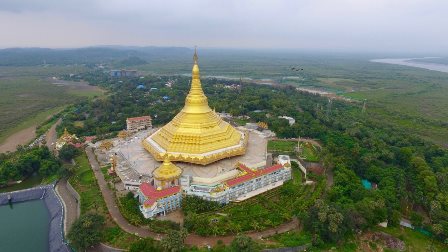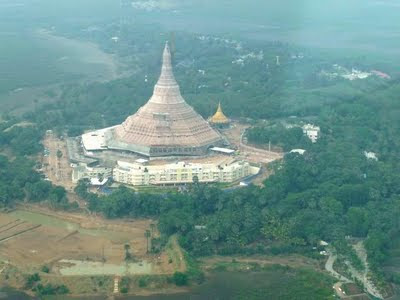" As you would pluck out a poisonous weed,
Pluck out the arrow of desire.
For he who is awake
Has shown you the way of peace.
Give yourself to the journey.
'Here shall I make my dwelling,
In the summer and the winter,
And in the rainy season.'
So the foolish make plans,
Sparing not a thought for death.
Death overtakes one
Who, giddy and distracted by the world,
Cares only for their children, their property,
Death fetches them away
As a flood carries off a sleeping village.
Nobody can save one from death,
Not the father nor the sons.
Know this.
Seek wisdom, and purity.
Quickly clear the way."
Pluck out the arrow of desire.
For he who is awake
Has shown you the way of peace.
Give yourself to the journey.
'Here shall I make my dwelling,
In the summer and the winter,
And in the rainy season.'
So the foolish make plans,
Sparing not a thought for death.
Death overtakes one
Who, giddy and distracted by the world,
Cares only for their children, their property,
Death fetches them away
As a flood carries off a sleeping village.
Nobody can save one from death,
Not the father nor the sons.
Know this.
Seek wisdom, and purity.
Quickly clear the way."
- The Dhammapada
The Global Pagoda stands as inspiring reminder to getting our priorities in life right. For over ten years, many people from many busy walks of life have devoted their priceless time - including voluntary full-time service - towards realizing this Dhamma project, sharing with all beings the benefits of Vipassana and Dhamma service. The more time one invests in Dhamma service, more benefits one gains. By serving others, we serve ourselves.
 View of inner dome of main pagoda, in October 29, 2006, with participants worldwide during the function in which the bone relics of Gotama the Buddha were placed in the central locking stone of the dome. As the largest hollow, stone monument in the world, the inner dome serves as the world's largest meditation hall that can seat over 8,000 students in one-day refresher Vipassana courses.
View of inner dome of main pagoda, in October 29, 2006, with participants worldwide during the function in which the bone relics of Gotama the Buddha were placed in the central locking stone of the dome. As the largest hollow, stone monument in the world, the inner dome serves as the world's largest meditation hall that can seat over 8,000 students in one-day refresher Vipassana courses.
The Global Pagoda stands as a Dhamma symbol of compassion, of serving all beings on the universal, practical path leading to liberation from all misery.
There is no force on earth that can stop this Pagoda from being built, Principal Vipassana teacher Sayagyi U Goenka had declared over a decade ago at the Global Pagoda construction site. This Dhamma conviction has inevitably come true. The Global Pagoda is coming to life. Already many hundreds of visitors are flocking to see it. This number will soon turn into thousands daily.
In its life, expected to last for a thousand years, the Global Pagoda will be one of the most visited places on Earth. Where there is suffering, the way out of suffering will be an irresistible Dhamma attraction in life.
Where there is life, there is death. That life does not end with death, becomes clear to a Vipassana student.
In one of the most significant, most beneficial Dhamma articles written in our lifetime, Sayagyi U Goenka explains 'What happens at death?':
"To understand what happens at death, let us first understand what death is. Death is like a bend in a continuous river of becoming. It appears that death is the end of a process of becoming, and certainly it may be so in the case of an arahant (a fully liberated being) or a Buddha; but with an ordinary person this flow of becoming continues even after death. Death puts an end to the activities of one life, and the very next moment starts the play of a new life. On the one side is the last moment of this life and on the other side is the first moment of the next life. It is as though the sun rises as soon as it sets with no interval of darkness in between, or as if the moment of death is the end of one chapter in the book of becoming, and another chapter of life begins the very next moment.
Although no simile can convey the exact process, still one might say that this flow of becoming is like a train running on a track. It reaches the station of death and there, slightly decreasing speed for a moment, carries on again with the same speed. It does not stop at the station even for a moment. For one who is not an arahant, the station of death is not a terminus but a junction from where thirty-one different tracks diverge. The train, as soon as it arrives at the station, moves onto one or another of these tracks and continues. This speeding "train of becoming," fuelled by the electricity of the kammic reactions of the past, keeps on running from one station to the next, on one track or the other, a continuous journey that goes on without ceasing.
This changing of "tracks" happens automatically. As the melting of ice into water and the cooling of water to form ice happens according to laws of nature, so the transition from life to life is controlled by set laws of nature.
According to these laws, the train not only changes tracks by itself, it also lays the next tracks itself. For this train of becoming the junction of death, where the change of tracks takes place, is of great importance. Here the present life is abandoned (this is called cuti-disappearance, death). The demise of the body takes place, and immediately the next life starts (a process which is called patisandhi - conception or taking up of the next birth). The moment of patisandhi is the result of the moment of death; the moment of death creates the moment of conception. Since every death moment creates the next birth moment, death is not only death, but birth as well. At this junction, life changes into death and death into birth.
Thus every life is a preparation for the next death. If someone is wise, he or she will use this life to the best advantage and prepare for a good death. The best death is the one that is the last, that is not a junction but a terminus: the death of an arahant. Here there will be no track on which the train can run further; but until such a terminus is reached, one can at least ensure that the next death gives rise to a good birth and that the terminus will be reached in due course. It all depends on us, on our own efforts. We are makers of our own future, we create our own welfare or misery as well as our own liberation."
At the point of death - and as we know, death can arrive any moment - the only wealth we carry with us is the wealth of goodwill. What is there in our Bank of India account stays in this world. What is there in the Bank of Dhamma account comes with us.
A billionaire industrialist in Mumbai may be building a US$ 3 billion dollar home for him and his family. But when death takes him away, would he be able to carry with him even a single pillow cover from this $3 billion house? So it's wise to also invest in good will, in whatever little way we can, in sharing in whatever way possible the benefits we have gained.
The best investment is a Dhamma investment. The benefits of any Dhamma investment are timeless.
In time, like the great architectural wonders of the days of old, the Global Pagoda too will age, wither and die. Everything is impermanent. Anicca. A few thousand years from now, awe-struck people will gaze at its vast, fallen ruins and wonder, "From the size of these ruins, we can see thousands of people came here every day. What is it that brought them here?"
By probing further, they would know - like archaeologists of today discover the greatness of yesterday - that many from all across the globe had come to the Global Pagoda to practice Vipassana meditation, or to know more about this universal, practical quintessence of the teachings of a Buddha.
If by giving up a lesser happiness,
one may experience a greater happiness,
one is wise to give up the lesser happiness
for the sake of the greater happiness.
- The Dhammapada

